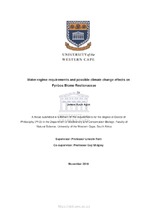Water regime requirements and possible climate change effects on Fynbos Biome Restionaceae
Abstract
The Cape Floristic Region (CFR) of southern Africa is one of the world’s most unique
biodiversity hotspots. However, this biodiversity continues to be threatened by habitat loss
due to rapid urbanisation, agriculture and alien vegetation encroachment, and now, by future
groundwater extraction and climate change. Previous work had shown that soil moisture is
important in structuring wetland plant communities at fine-scale. What is not fully known,
however, is how the spatial distribution of species at a local scale is related to soil hydrology
and what the response in the future of species distributions will be to perturbations arising
from changes in climate or subsurface moisture in the future. The current research
investigated the water regime of the Restionaceae which is a key family in the Fynbos biome
and the implications of possible changes in soil hydrology caused by climate change in
communities within this region. The Restionaceae were particularly appropriate because
they are shallow rooted perennials with the ability to tolerate a wide range of water regimes
which allows them to successfully co-habit within mixed plant communities as segregated
clusters along fine-scale hydrologic gradients. Vegetation survey counts for the presence of
these species along with measurements of soil water table depth and moisture content data
generated from eight small-scale plots (50 x 50 m) were used to investigate the possible
hydrological niches and to envision the potential impacts of a substantial reduction in rainfall
and an increase in temperature as projected by Global Climate Models (GCMs) on the
structure of Restionaceae communities in seasonal wetlands by 2100. A comparative
analysis of the effects of two extreme Representative Concentration emission Pathways
(RCP2.6 and RCP8.5) on significant hydrological variables to plant water regimes was
carried out. The IPCC AR5 report describes the RCP8.5 emissions scenario as the likely
‘business as usual’ scenario where emissions continue to rise through the 21st century while
the RCP2.6 scenario assumes that emissions peak between 2010 and 2020 and
substantially subside thereafter.

